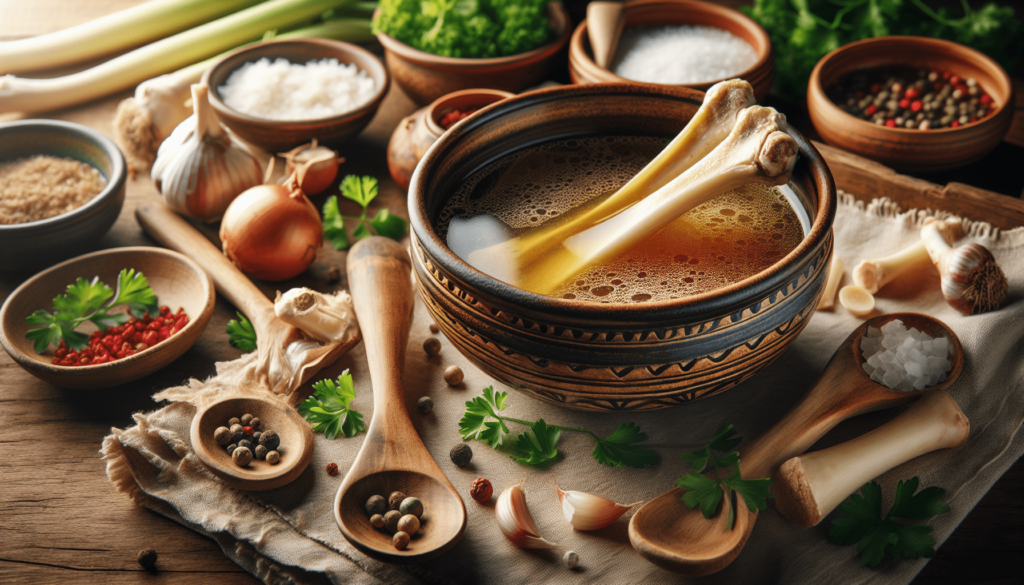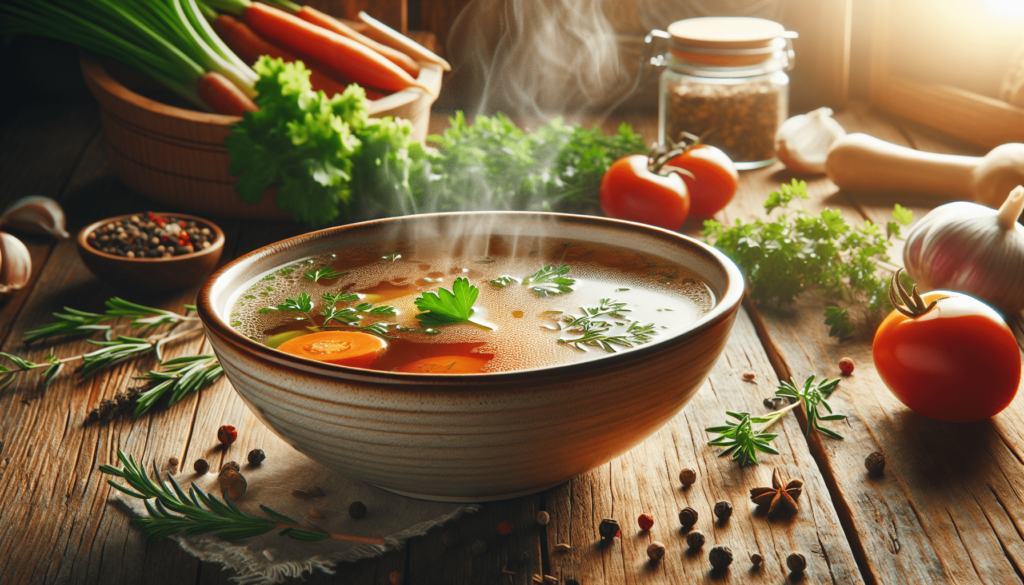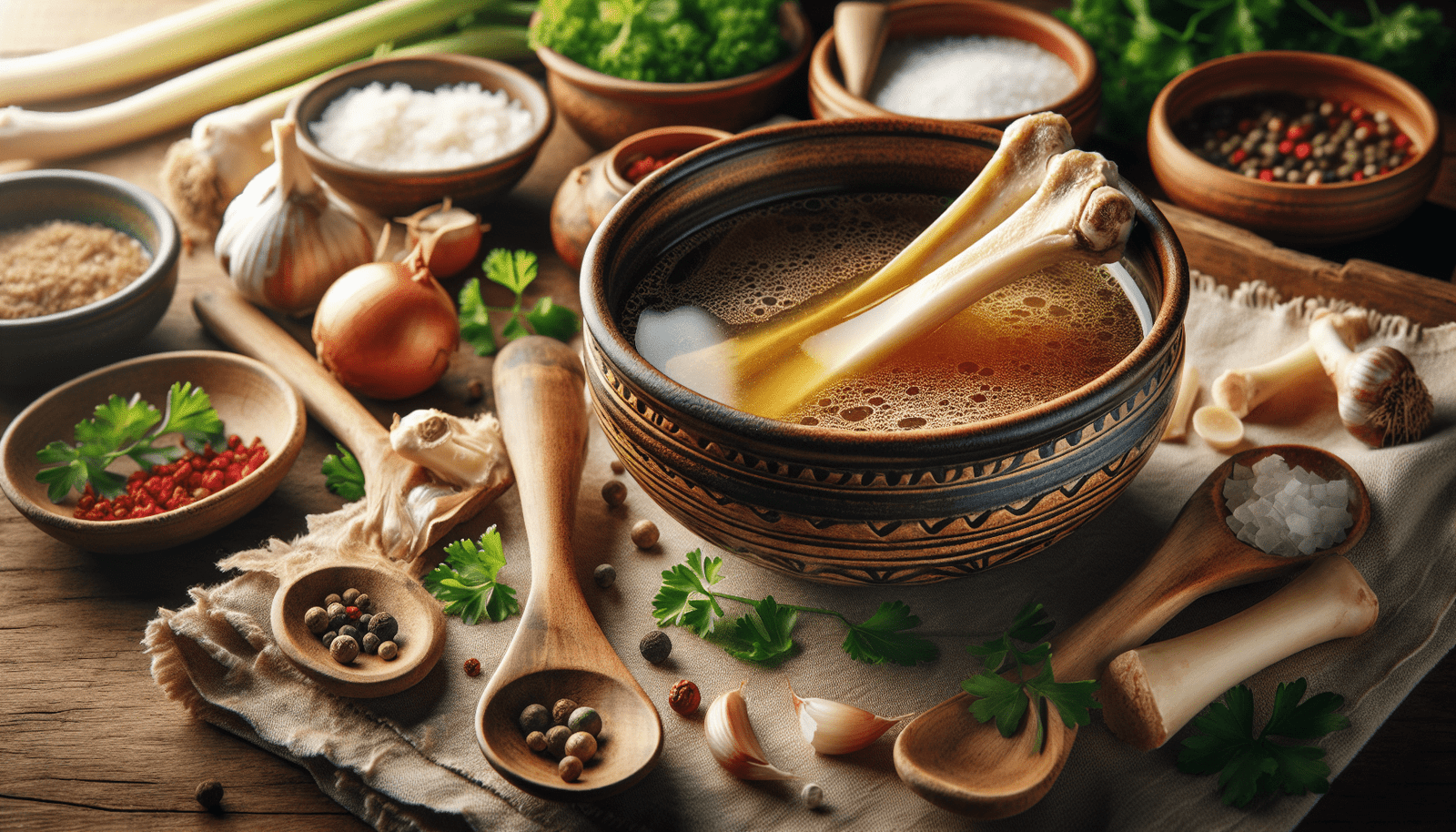Are you curious about the latest trend in healthy eating? Well, look no further because bone broth is taking the health and wellness world by storm! Packed with nutrients and believed to have numerous health benefits, bone broth is becoming a staple in many kitchens. So, what exactly is bone broth and why is everyone buzzing about it? Let’s uncover the secrets behind this popular food trend.

What is Bone Broth?
Definition of Bone Broth
Bone broth is a nutritious and flavorful liquid made by simmering animal bones, along with vegetables, herbs, and spices, in water for an extended period of time. The slow cooking process extracts the nutrients and minerals from the bones, resulting in a rich and savory broth.
Ingredients Used in Bone Broth
The main ingredients used to make bone broth are animal bones, such as chicken, beef, or fish bones. These bones are typically sourced from high-quality, grass-fed or organic animals. Additionally, vegetables like onions, carrots, and celery are often added for added flavor and nutritional value. Various herbs and spices, such as bay leaves, thyme, and black peppercorns, can be included to enhance the taste of the broth.
Health Benefits of Bone Broth
Bone broth is not only delicious but also packed with health benefits. It is known to promote gut health, boost the immune system, support joint health, aid in weight loss, and improve skin health. The high protein content, along with essential vitamins, minerals, and other nutrients, make bone broth a nourishing addition to any diet.
The History of Bone Broth
Ancient Origins of Bone Broth
The origins of bone broth can be traced back thousands of years to ancient civilizations. It was commonly consumed by various cultures, including the ancient Egyptians, Greeks, and Chinese. In these societies, bone broth was revered for its healing properties and was often used as a remedy for various ailments.
Cultural Significance of Bone Broth
Bone broth has not only stood the test of time but also holds cultural significance in different parts of the world. In traditional Chinese medicine, it is believed that bone broth strengthens the kidneys and nourishes the blood. In Jewish culture, bone broth, known as “Jewish penicillin,” has been used for generations as a remedy for illness. The cultural importance of bone broth showcases its widespread recognition and acceptance as a beneficial food.
Nutritional Value of Bone Broth
Protein Content in Bone Broth
Bone broth is a great source of protein, which is essential for the growth and repair of tissues in the body. The prolonged cooking process helps break down the collagen in the bones, resulting in a gelatinous broth that is rich in amino acids, the building blocks of protein.
Vitamins and Minerals in Bone Broth
Bone broth is a treasure trove of vitamins and minerals. It contains high levels of calcium, magnesium, phosphorus, and other minerals that are important for maintaining healthy bones and teeth. It is also a rich source of vitamins, including vitamin A, vitamin K, and various B vitamins, which play vital roles in different bodily functions.
Other Nutrients in Bone Broth
In addition to protein, vitamins, and minerals, bone broth is also rich in other nutrients. It contains collagen, which is beneficial for joint health and skin elasticity. It also contains glycine and proline, amino acids that support overall gut health and aid in digestion. These various nutrients make bone broth a nutrient-dense food that can enhance overall well-being.
Health Benefits of Bone Broth
Promotes Gut Health
Bone broth is known for its ability to promote gut health. The collagen and gelatin found in bone broth help to repair and strengthen the gut lining, reducing inflammation and enhancing nutrient absorption. It can also improve digestion and alleviate symptoms of gastrointestinal disorders such as leaky gut syndrome and irritable bowel syndrome.
Boosts Immune System
The nutrients found in bone broth, such as vitamins, minerals, and amino acids, help boost the immune system and support overall immune function. The amino acids, in particular, play a vital role in the production of immune cells, helping to protect the body against illness and infection. Regular consumption of bone broth can help strengthen the body’s natural defense mechanisms.
Supports Joint Health
The collagen and other compounds found in bone broth are beneficial for joint health. Collagen helps to maintain the integrity of cartilage, reducing joint pain and improving mobility. Glucosamine and chondroitin, which are naturally present in bone broth, also help to support joint health and alleviate symptoms of conditions like osteoarthritis.
Aids in Weight Loss
Bone broth is a great addition to any weight loss program. It is low in calories, yet high in protein, which can help you feel fuller for longer and reduce cravings. The gelatin in bone broth also helps to support a healthy metabolism and can aid in the breakdown of fats.
Improves Skin Health
The collagen and amino acids in bone broth contribute to healthier and more radiant skin. Collagen helps to maintain skin elasticity, preventing wrinkles and promoting a youthful appearance. The amino acids glycine and proline also support skin regeneration, helping to heal wounds and blemishes.

How to Make Bone Broth
Selecting the Right Bones
When making bone broth, it is crucial to select high-quality bones. Look for bones from grass-fed or organic animals, as they will provide the best nutritional value and flavor. Chicken carcasses, beef marrow bones, and fish frames are popular choices for making bone broth.
Preparing the Bones
Before starting the cooking process, it is essential to prepare the bones properly. This can be done by roasting them in the oven to enhance the flavor and remove any impurities. It is important to remove any excess fat or meat from the bones before simmering them in water.
Cooking Methods
There are several cooking methods to choose from when making bone broth. The most common method is to simmer the bones in water for an extended period, typically ranging from 12 to 24 hours. This slow cooking process allows for the extraction of nutrients and flavors from the bones. Another popular method is using a pressure cooker or Instant Pot, which significantly reduces the cooking time to a few hours.
Seasonings and Flavorings
To enhance the taste of bone broth, various seasonings and flavorings can be added. Common additions include onions, carrots, celery, garlic, and herbs like bay leaves and thyme. Salt and pepper can be used to season the broth to taste. Experimenting with different flavor combinations can add variety to the broth and cater to personal preferences.
Different Variations of Bone Broth
Chicken Bone Broth
Chicken bone broth is one of the most popular variations of bone broth. It has a mild and comforting flavor that pairs well with a variety of dishes. Chicken bones, such as carcasses or leftover roasted chicken bones, are simmered to create a rich and nourishing broth.
Beef Bone Broth
Beef bone broth is known for its robust and hearty flavor. Beef marrow bones, knuckles, or joints are typically used to make this variation of bone broth. The longer cooking time intensifies the flavors, resulting in a deeply satisfying broth.
Fish Bone Broth
Fish bone broth is a lighter and more delicate alternative to meat-based broths. Fish frames, usually from white fish like cod or sole, are simmered to extract the flavors and nutrients. Fish bone broth is often used as the base for seafood soups and chowders.
Vegetable Bone Broth
Vegetable bone broth is a versatile option for vegetarians or those who prefer a plant-based diet. It is made by simmering a variety of vegetables, such as onions, carrots, celery, and mushrooms, in water. Although it may not have the same richness as meat-based broths, vegetable bone broth can still provide a nutritious and flavorful alternative.
Using Bone Broth in Cooking
Broth as a Base for Soups and Stews
One of the most common uses for bone broth is as a base for soups and stews. The rich flavors and nutrients in bone broth can elevate any soup or stew recipe, providing depth and complexity. Whether it’s a classic chicken noodle soup or a hearty beef stew, bone broth adds a delicious touch to any dish.
As a Flavorful Cooking Liquid
Bone broth can also be used as a cooking liquid for grains, such as rice or quinoa, and for cooking vegetables. Instead of using plain water, using bone broth adds a savory flavor to the dish and enhances its nutritional value. It can be a great substitute for water or stock in various recipes, resulting in a more flavorful end product.
As a Nutrient-rich Addition to Recipes
Bone broth can be incorporated into a variety of recipes to enhance their nutritional value. It can be added to sauces, gravies, and marinades to provide a rich and flavorful base. It can also be used to deglaze pans or simmer vegetables, infusing them with a nourishing boost. The versatility of bone broth allows for endless possibilities in the kitchen.
The Bone Broth Craze
Popularity among Health Enthusiasts
In recent years, bone broth has experienced a surge in popularity among health enthusiasts. Its numerous health benefits and nutritional value have attracted attention from those seeking to improve their overall well-being. Many people swear by the healing properties of bone broth, incorporating it into their daily routine for its potential health effects.
Celebrity Endorsements
The bone broth trend has received further endorsement through the support of celebrities and influencers. Well-known figures in the health and wellness industry have praised bone broth for its positive impact on their health and appearance. These endorsements have helped to popularize bone broth and spread awareness of its potential benefits to a wider audience.
Commercial Availability
Due to the rising popularity of bone broth, it is now readily available in many grocery stores and online platforms. Various brands offer pre-packaged bone broth, making it convenient for those who don’t have the time or resources to make it at home. However, it is important to read labels and choose brands that prioritize quality and transparency in their sourcing and production process.
Possible Concerns and Precautions
Sourcing High-Quality Bones
When making bone broth, it is crucial to source high-quality bones from reputable sources. Look for grass-fed or organic animals to ensure that the bones are free from antibiotics, hormones, and other contaminants. The quality of the bones directly impacts the nutritional value and taste of the bone broth.
Careful Preparation and Handling
Proper preparation and handling of bones are essential to ensure food safety when making bone broth. Thoroughly clean the bones before cooking, and handle them with clean utensils to avoid cross-contamination. It is also important to cook the bones at a temperature that kills any harmful bacteria and pathogens to maintain food safety.
Potential for Allergies or Intolerances
While bone broth is generally well-tolerated, some individuals may have allergies or intolerances to certain ingredients used in the broth, such as onions or celery. It is important to be aware of any food sensitivities and adjust the recipe accordingly. If experiencing any adverse reactions after consuming bone broth, it is best to consult a healthcare professional.
Excessive Consumption
As with any food or beverage, moderation is key. While bone broth offers numerous health benefits, excessive consumption may lead to an imbalance in certain nutrients or compounds. It is important to incorporate bone broth as part of a balanced and varied diet, enjoying it as a nourishing addition rather than relying solely on it for all nutritional needs.
Incorporating Bone Broth into Your Diet
Daily Consumption Recommendations
The ideal daily consumption of bone broth varies depending on individual needs and dietary preferences. As a general guideline, consuming a cup or two of bone broth per day can provide a good amount of nutrients and support overall health. However, it is best to listen to your body and adjust the amount according to your specific goals and requirements.
Creative Ways to Include Bone Broth
In addition to using bone broth as a base for soups and stews, there are many creative ways to incorporate it into your diet. Use it as a cooking liquid when making rice, quinoa, or other grains to infuse them with a savory flavor. Blend it into smoothies or soups for an extra nutritional boost. You can even freeze bone broth in ice cube trays and use them as a flavor enhancer in various recipes.
Adding Bone Broth to Existing Recipes
Another way to include bone broth in your diet is by adding it to existing recipes. Use it to deglaze pans when making sauces or gravies, or add it to marinades for an extra depth of flavor. You can also substitute water or stock with bone broth in recipes that call for liquid, such as braises or slow-cooked dishes. Get creative and experiment with different recipes to discover new ways to enjoy the benefits of bone broth.
In conclusion, bone broth is a versatile and nutrient-dense food that offers numerous health benefits. From promoting gut health to supporting joint health and aiding in weight loss, bone broth has gained recognition in various cultures throughout history. Whether you choose to make it at home or purchase it from a trusted source, bone broth can be a delicious and nourishing addition to your daily diet. So why not give bone broth a try and experience the buzz for yourself?

